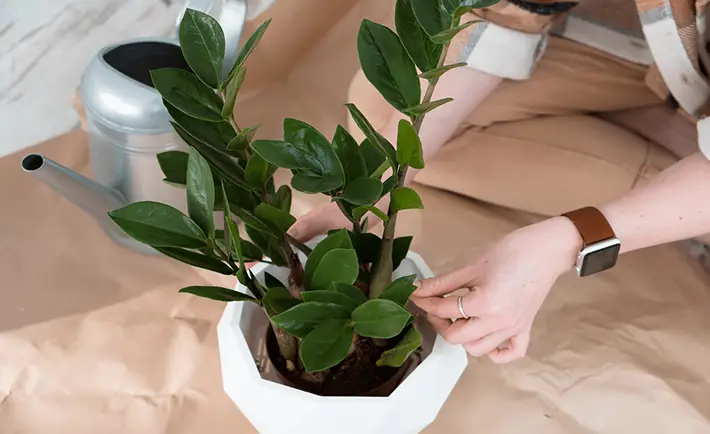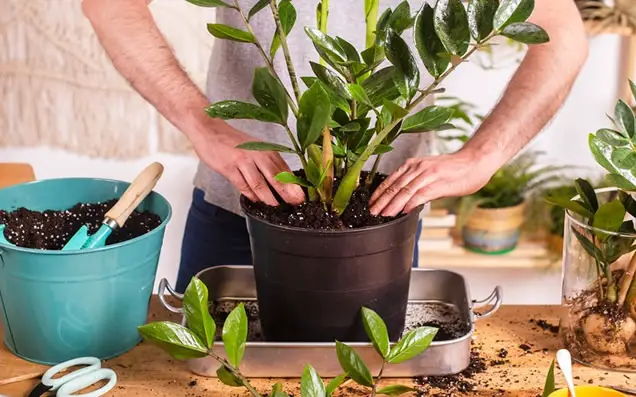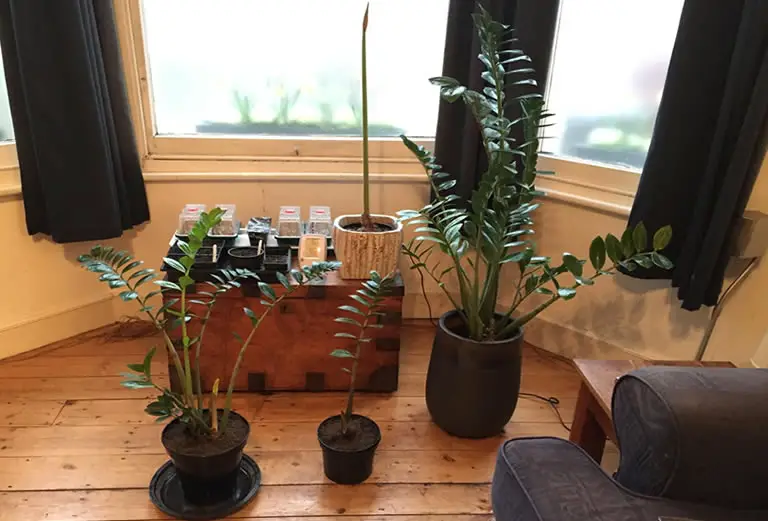ZZ plants are a favorite among houseplant lovers, thanks to their glossy leaves and striking upright stems. Known for being low-maintenance and resilient, they’re perfect for anyone looking for an easy-care plant. Plus, they grow surprisingly fast and can reach an impressive size with the right care.
In this guide, we’ll break down everything you need to know about how fast ZZ plants grow, how big they can get, and what you can do to help yours reach its full potential.
Table of Contents
- ZZ Plant Growth Rate
- How Big Do ZZ Plants Get?
- How Long Does It Take for a ZZ Plant to Grow?
- When Is the ZZ Plant’s Growing Season?
- How to Speed Up ZZ Plant Growth
- Watering ZZ Plants For Best Growth
- Fertilizing ZZ Plants for Maximum Growth
- Why Isn’t My ZZ Plant Growing?
- Are ZZ Plants Easy to Grow?
- How to Make a ZZ Plant Bushy
- Why Is My ZZ Plant’s New Growth Dying?
ZZ Plant Growth Rate
So, how fast does a ZZ plant grow?
Most ZZ plants produce 1-3 new stems every few months during the growing season. New stems grow 6-12 inches per month and can reach 3 to 5 feet tall within one growing season. ZZ plants spread horizontally by about an inch per year, but they rarely reach more than 2 feet in diameter.
ZZ plants (Zamioculcas zamiifolia) are surprisingly fast growers, with new shoots shooting up at a rate of 6–12 inches (15–30 cm) per month.
Under the right conditions, they can reach an impressive height of up to 5 feet!
On average, they produce about 6–8 new stems per growing season, with the most active growth happening from early spring through summer.
As fall sets in, growth slows down, and by winter, it mostly comes to a halt.
If your ZZ plant is pushing out new shoots, that’s a great sign—it means it’s happy with its care. But if it hasn’t grown in a while, it might be time to check if it’s getting enough light, water, and nutrients.
ZZ plants grow from underground rhizomes, which are thick, modified stems that store water and nutrients. From these rhizomes, new stems grow upward while roots spread downward.
Even if your plant is a bit rootbound, it can still push out fresh growth between its existing foliage, making it a resilient and adaptable houseplant.

How Big Do ZZ Plants Get?
ZZ plants come in a variety of sizes, making them a great fit for any space. On average, they grow to about 1–2 feet (30–61 cm) tall and are typically sold in 6–8 inch pots.
Smaller ZZ plants, often just 6–8 inches tall with only a couple of stems, are usually found in 4-inch (10 cm) pots. On the other hand, larger, more mature ZZ plants can reach an impressive 3–5 feet in height and comfortably fill an 8–12 inch pot.
For reference, here are some key stats from my own large ZZ plant (pictured below), showing the range of its smallest and largest dimensions.
Here are the key measurements of my large ZZ plant:
- Stem height: 3–4 feet (91–122 cm)
- Leaf length: 3–5 inches (7.6–12.7 cm)
- Leaf width: 2–3 inches (5–7.6 cm)
- Stem width: 1–2 inches (2.5–5 cm)
- Pot diameter: 8 inches (20.3 cm)
These numbers give a good idea of how big ZZ plants can get when given the right care. With enough light, water, and space to grow, they can become stunning, statement-making houseplants!
How Long Does It Take for a ZZ Plant to Grow?
Growing a ZZ plant from a small 1–2 stem starter plant into a full-sized beauty takes about 3–5 years. On average, they produce 6–8 new stems per year and expand outward by about an inch in diameter annually.
However, their growth rate depends heavily on factors like light, water, nutrients, and overall care. A well-cared-for ZZ plant will grow much faster than one struggling with poor conditions.
When Is the ZZ Plant’s Growing Season?
ZZ plants grow in response to light levels, so their active season depends on their environment.
- In temperate climates, growth kicks off in early spring and continues until mid-autumn, slowing down as daylight decreases.
- In tropical climates, where light and warmth are consistent, ZZ plants can keep growing year-round.
The first sign of new growth is usually a fresh shoot emerging from the rhizome beneath the soil—a sure sign that your ZZ plant is ready to take off for another season!
How to Speed Up ZZ Plant Growth
If you want your ZZ plant to grow faster, focus on giving it the best possible care. Here are the key factors that can boost its growth rate:
- Increase light exposure – Bright, indirect light helps ZZ plants grow faster. While they tolerate low light, more light means more energy for growth.
- Keep temperatures warm – Aim for temperatures at the higher end of their preferred range (65–85°F / 18–29°C).
- Water correctly – Avoid overwatering or underwatering by letting the soil dry out between waterings but not for too long.
- Feed regularly – Use a balanced houseplant fertilizer every 4–6 weeks during the growing season.
- Minimize stress – Keep your plant away from drafts, sudden temperature changes, pests, and disease to maintain steady growth.
- Maintain proper humidity – While ZZ plants tolerate low humidity, keeping it moderate to high can encourage healthier, quicker growth.
Up next, we’ll go into more detail on each of these points to help your ZZ plant thrive at its fastest pace!
Adequate light
ZZ plants have a reputation for being low-light plants, but this is only partly true. Whilst ZZ plants can tolerate low light conditions for a prolonged period of time, they will not produce new growth or thrive without adequate lighting.
ZZ plants do best in bright, indirect lighting, although they can tolerate 1-2 hours of direct sunlight in the early morning or late afternoon.
Lighting changes from room to room and drops dramatically as you move a plant further from a window. It also changes depending on the weather and season outside.
I like to use a light meter app on my phone to give me an idea of whether I should move my ZZ plant to a position that is more or less bright.
You can download a light meter app from the Google Play or Apple store for your smartphone.
Watering ZZ Plants For Best Growth
Whilst ZZ plants have a reputation for tolerating drought, they tend to grow slower, and produce smaller stems and leaves in water-deficient conditions.
Don’t overdo the watering either, as ZZ plants are reasonably prone to root rot, which will stop all growth in its tracks and can lead to your plant dying.
Water your ZZ plant thoroughly once the top half of the soil feels dry, and make sure to let the pot drain well before placing your plant back in its normal spot.
Be sure to read our extensive ZZ plant watering guide.

Fertilizing ZZ Plants for Maximum Growth
Providing your ZZ plant with the right nutrients can significantly boost its growth. Whether you mix compost into the soil when potting or use fertilizer every few months, a little extra nutrition can make a big difference.
However, be cautious—too much fertilizer can damage the roots and slow down or even stop growth. I prefer using a water-soluble synthetic fertilizer at half the recommended strength every two months during the growing season. This provides steady nourishment without the risk of overfeeding.
Why Isn’t My ZZ Plant Growing?
ZZ plants stop growing when their conditions aren’t ideal or when they’re stressed by improper care. The most common reasons for slow or stalled growth include:
- Inadequate light – Low light slows down growth, while bright, indirect light helps them thrive.
- Overwatering or underwatering – Too much or too little water can stress the plant and stunt growth.
If you’ve ruled out lighting and watering issues, here are other factors to check:
1. Is Your ZZ Plant Rootbound?
Once a ZZ plant’s roots completely fill its pot, it becomes harder for the plant to grow. If you see roots poking out of the drainage holes, it’s time to repot into a slightly larger container to give it room to expand.
2. Are There Pests or Diseases?
Inspect your plant closely for any signs of pests or disease, like yellowing leaves, sticky residue, or webbing. If you spot any issues, treat them immediately and isolate your plant from others to prevent the problem from spreading.
3. Is Temperature Stress Slowing Growth?
ZZ plants prefer temperatures between 55–85°F (13–29°C). If they’re exposed to hot or cold drafts from windows, AC vents, or heating appliances, they may stop growing. Keep your plant in a stable, draft-free environment to avoid stress.
By addressing these common issues, you can help your ZZ plant get back on track and encourage healthy, consistent growth! For dealing with other common growth issues read our article about ZZ plant problems.
Are ZZ Plants Easy to Grow?
Yes! ZZ plants are one of the easiest houseplants to grow and can handle less-than-perfect conditions without much trouble.
The key to keeping them healthy is providing good lighting and avoiding overwatering.
While less-than-ideal conditions may slow their growth, ZZ plants are far less demanding than many other houseplants, making them a great choice for beginners.
You can gain more understanding of how to grow ZZ plants by reading our ZZ plant propagation guide.
How to Make a ZZ Plant Bushy
If you want your ZZ plant to grow full and bushy, focus on giving it plenty of light and providing consistent care.
A bushy ZZ plant develops when it produces lots of new stems, so creating the right environment will encourage more growth.
On the flip side, a stressed or unhappy ZZ plant can drop leaves, making it look sparse.
That’s why maintaining good lighting, proper watering, and a stable environment is essential for growing a lush, healthy plant!
Why Is My ZZ Plant’s New Growth Dying?
If the new shoots on your ZZ plant are dying, the most common culprit is overwatering. Too much moisture can lead to yellowing lower leaves and brown tips on fresh growth.
If overwatering isn’t the issue, your plant is likely experiencing another form of stress.
Take a close look at its environment and recent care—changes in lighting, temperature, pests, or nutrient deficiencies could all be factors. Identifying and addressing the root cause will help your ZZ plant bounce back.
Final Thoughts
ZZ plants come in a variety of sizes, so it’s best to choose one that fits your space. Smaller plants look great on desks and windowsills, while larger specimens make beautiful statement floor plants.
If you want your ZZ plant to grow big and healthy, focus on consistent care, proper lighting, and avoiding common stressors. With the right conditions, your ZZ plant will thrive for years to come!
For an optimum ZZ plant our ZZ plant care guide. 🌿

